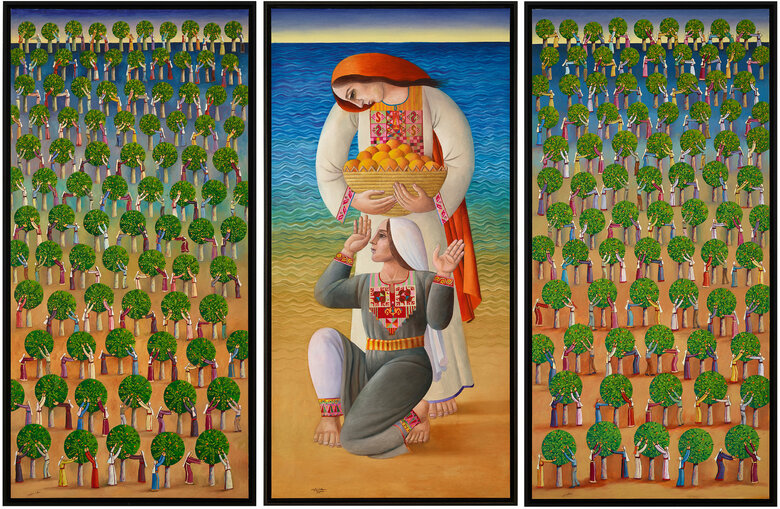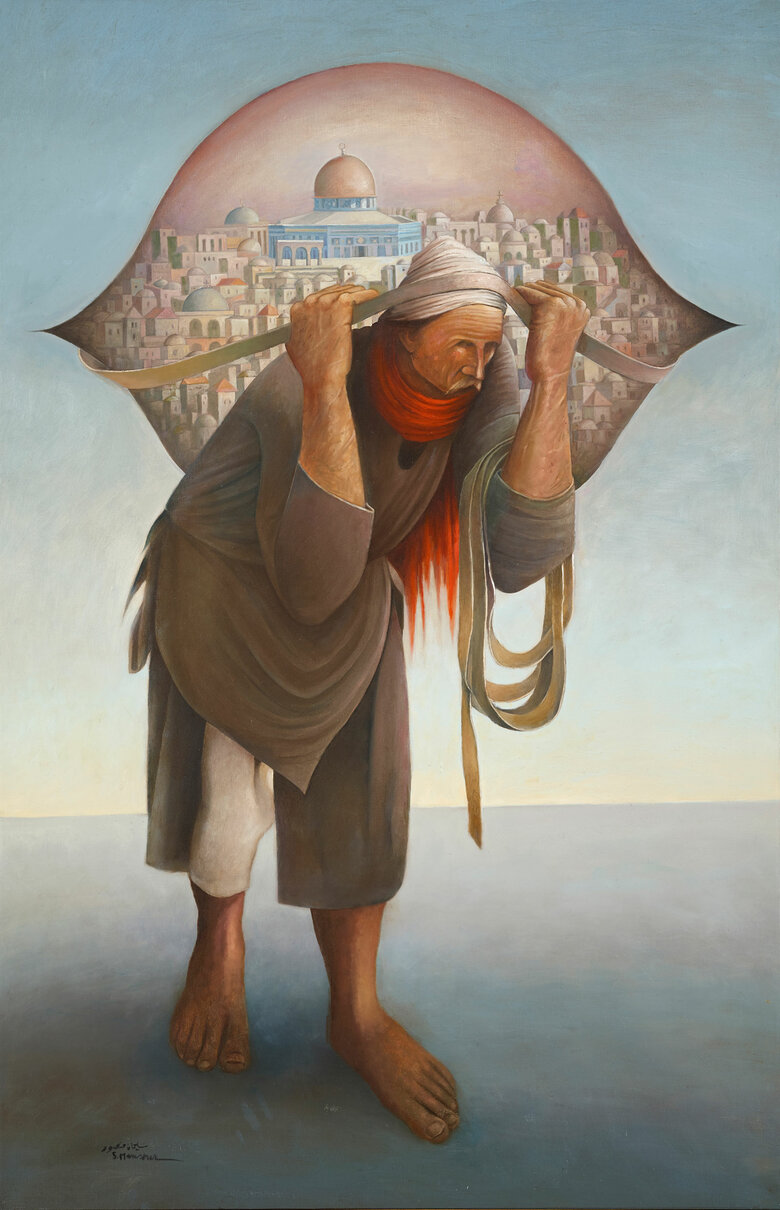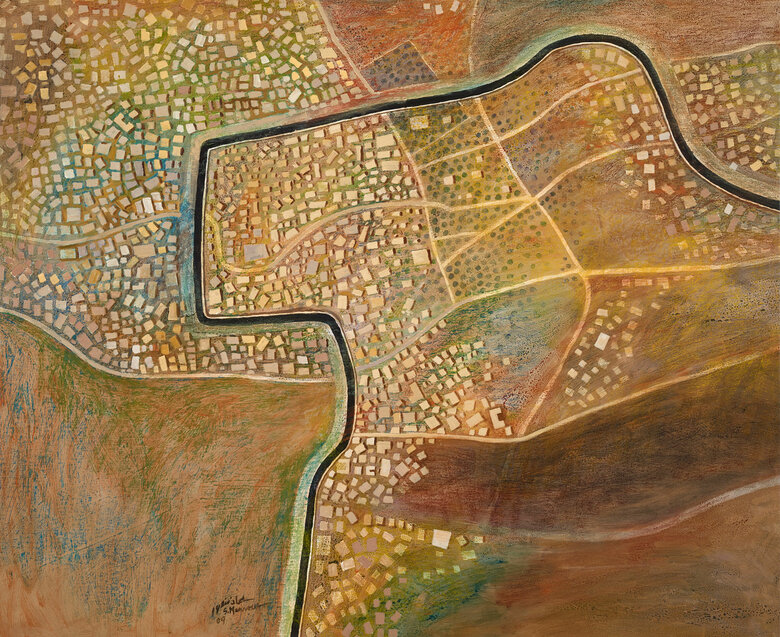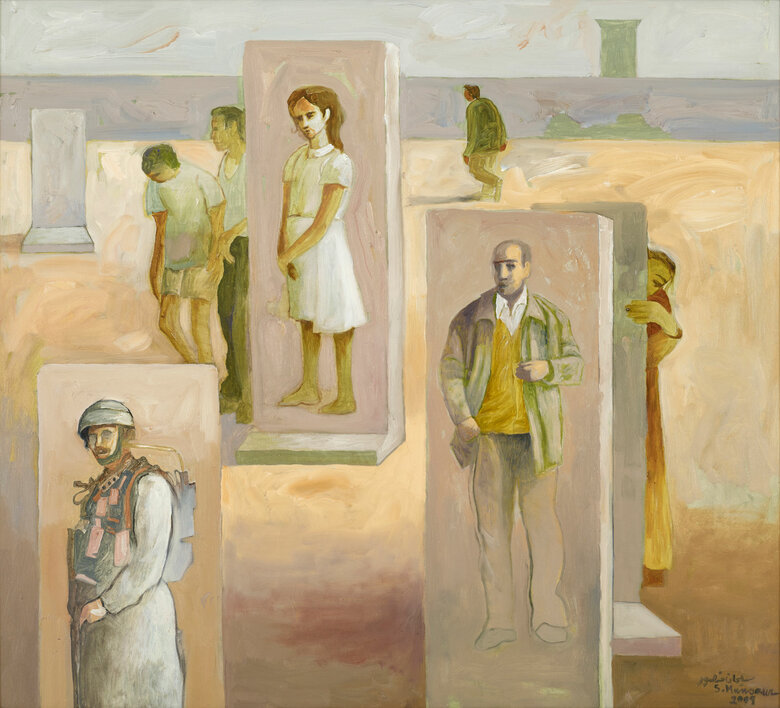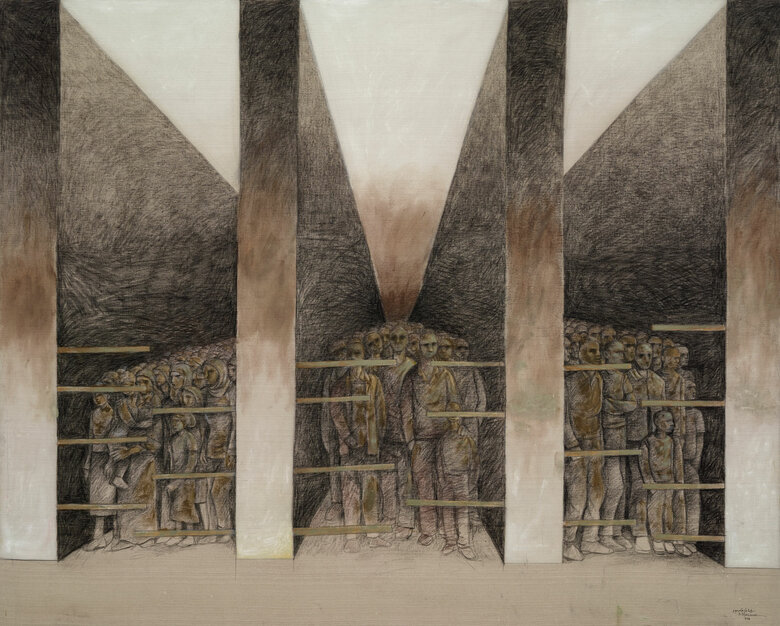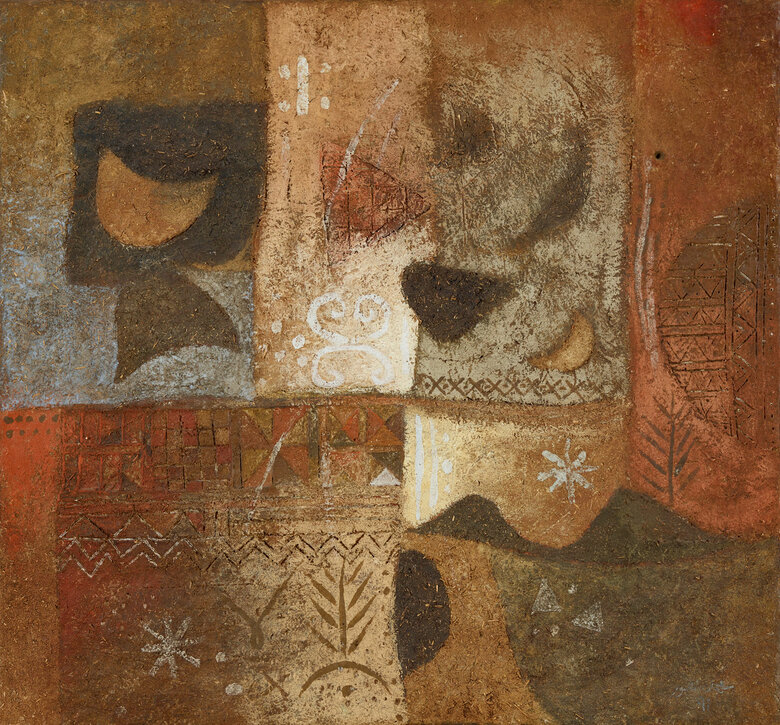Born in Birzeit, Palestine, in 1947, Sliman Mansour is a painter, sculptor, and cartoonist who played a pivotal role in shaping Palestinian modern art and in building an infrastructure for the arts...
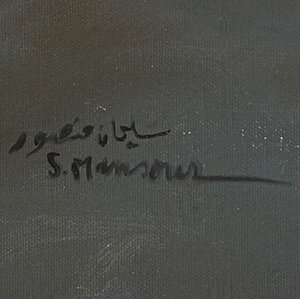

SLIMAN ANIS MANSOUR, Palestine (1947)
Bio
Written by WAFA ROZ
Born in Birzeit, Palestine, in 1947, Sliman Mansour is a painter, sculptor, and cartoonist who played a pivotal role in shaping Palestinian modern art and in building an infrastructure for the arts in the West Bank. The fourth son in a family of six, Mansour lost his father at the age of four and moved to Bethlehem, where he studied and boarded at the Evangelical Lutheran School. Mansour showed a profound interest in art at an early age, mentored by Felix Theis, a German art teacher who introduced him to European art history. He enrolled at the Bezalel Art Academy in West Jerusalem in 1967, where he studied drawing and painting under Yossi Stern and Joseph Hirsch. One of the few Palestinians at Bezalel, Mansour earned his BFA in 1970, after which the artist co-founded the League of Palestinian Artists (1973). He was the head of the league from 1979 to 1982 and 1986 to 1990, and founded the Al Wasiti Art Center in Jerusalem in 1994, serving as director from 1995 to 1996. In addition to teaching at Al Quds University, he participated in the establishment of the Palestinian Association for Contemporary Art in 2004 and the International Academy of Art in 2006, both in Ramallah.
Mansour was born at the dawn of the Nakba, and as a young adult, he lived through the Naksa, which marks Israel’s victory in the 1967 Six-Day War and subsequent seizure of the West Bank, Gaza Strip, Golan Heights, and the Sinai Peninsula. Between 1967 and 1970, he lived in East Jerusalem, which had been occupied during the war, while studying in West Jerusalem, already formally a part of the Israeli state. As a result, his work during this period related to his experiences of estrangement, distress, and oppression, expressed in an idealistic style that reflected triumph amidst melancholy.
During his early career, Mansour took on portrait commissions and built an oeuvre inspired by Christian icons he encountered at church with his grandfather, the priest Boulos Khoury. He used charcoal and pastel to express his disappointment following the Naksa, as seen in Torso or Reclining Nude (1968). Along with many of his contemporaries, Mansour focused on developing Palestinian national art throughout the 1970s and 1980s, working to promote and preserve the history and identity of his people. In conversation with the work of his predecessor, Ismail Shammout, and his contemporary, Nabil Anani, Mansour chose to show his homeland as a paradise lost, creating dreamlike, iconic works that later became part of the Palestinian visual vernacular.
His celebrated painting Jamal al Mahamel, or The Camel of Hardships (1973), portrays exile from within occupied Palestine: burdened by longing and loss, a fatigued old porter is shown carrying Jerusalem on his back from within an endless void. Mansour illustrated Jerusalem as a glowing, utopian city with meticulous architecture, the Dome of the Rock disproportionately large behind the porter’s head. This painting and many others by Mansour were reproduced as posters or postcards for ease of acquisition and circulation, serving the cause and preserving visual history. Reproduce their artworks in prints was especially crucial for the Palestinian artists at this time because there were virtually no permanent galleries or art centers in occupied Palestine until the mid-1990s.
Mansour choose not to represent the urbanization that took place in Occupied Palestine, instead prioritizing the nostalgia of pastoral landscapes. With oil or acrylic on canvas, he produced idealized scenes of Palestinian villages, harvesting, and peasantry to reflect on labor and group harmony. To preserve collective memory and celebrate the importance of steadfastness, he adopted symbols such as the dove of hope and key of return, as well as orange and olive groves suggestive of harmony before the Nakba and resilience after the Naksa, respectively. Resonating assurance and grace, a female figure wearing an embroidered thobe became the centerpiece of his paintings. She epitomized the motherland as caretaker and nation-builder, as seen in Carrying Jerusalem (1979) and The Village Awakens (1988).
In Bride of the Homeland (1976), the central female figure is not wearing traditional dress, nor does she radiate the pride and determination of Mansour’s other heroines. Instead, the somber composition shows her lying dead on the ground, blood pooling beneath her young head. This painting commemorates Lina Nabulsi, a teenage girl killed by Israeli forces in 1976, who Mansour honors as a martyr and “bride” of Palestine. He revisits this tragic theme in Lina’s 58th Birthday (2017), paying tribute to the life the young woman should have lived. The 1976 and 2017 compositions mirror each other, and in both iterations, Mansour’s wife served as the figure model.
Suleiman Mansour co-established Along with artists Nabil Anani, Vera Tamari, and Tayseer Barakat, the New Vision Movement in the 1990s. During the First Intifada (1987-1993), they boycotted Israeli art supplies utilizing local materials instead. Mansour created abstract paintings on slabs of mud and straw, a technique he learned from his maternal grandmother. Using the names of destroyed and depopulated Palestinian villages as titles and illustrating their shapes with natural dyes and henna, Mansour conveyed his idea of home by elevating indigenous craftsmanship to the level of fine art.
Drawing on ancient history, Mansour created works inspired by Canaanite, Sumerian, Islamic art, as well as Arabic calligraphy. He saw cracks in mud as a metaphor for the fragmentation of Palestine and produced related sculptural works and self-portraits in bas-relief. In his seminal installation I Ishmael (1996), which earned him the Grand Nile Prize at the 1998 Cairo Biennial, Mansour used cracked clay to shape a male figure onto a wooden panel. The work was reminiscent of ancient tombs and commemorated Ismail, son of Hagar, who, like Mansour, was doomed to exile.
By the turn of the millennium, Mansour’s utopic enthusiasm waned and was replaced by a more complex, muted aesthetic, which introduces elements of hopelessness and resignation in depictions of the homeland. The woman that once represented triumph and glory is soberly portrayed beside an olive tree with a cup of coffee in Quiet Morning (2009). Separation walls and military checkpoints appear in works such as Homeland, 2010, part of a recurring gray color scheme showing figures trapped in oppressive concrete.
Nevertheless, Mansour’s work continues to embody the hope and resilience at the heart of Palestinian resistance. The artist lives and works in Jerusalem.
Sources
Boullata, Kamal. Palestinian Art, 1850-2005. London: Saqi, 2009.
Ankori, Gannit. Palestinian Art. London: Reaktion Books, 2006.
"Jerusalem: City of Dreams - Institute for Palestine Studies." Accessed September 20, 2018. http://www.palestine-studies.org/sites/default/files/jq-articles/49_Jerusalem_2.pdf
"Imaging Palestine as the Motherland - Hagar Art Gallery." Accessed September 20, 2018. http://www.hagar-gallery.com/Catalogues/Self_Portrait_03_01.pdf
The Power of Place and the Representation of Landscape in the Work of Palestinian Artists. Accessed September 20, 2018. http://virtualgallery.birzeit.edu/media/artical?item=11773
"Visual Arts and Creative Direct Action in Palestine." Accessed September 20, 2018. https://thesis.eur.nl/pub/10746/111130-RP-CGR-Final.pdf
Made in Palestine - Sliman Mansour. Accessed September 20, 2018. https://www.stationmuseum.com/Made_in_Palestine-Sliman_Mansour/Made_in_Palestine-Sliman_Mansour.html
"Aaron's Reports." Cracked and Shrinking Maps: An Interview with Palestinian Artist Sliman Mansour | Aaron's Reports. Accessed September 20, 2018. https://aaron.resist.ca/cracked-and-shrinking-maps-an-interview-with-palestinian-artist-Sliman-mansour
Sliman"Alhoush.com's Artist - Sliman Mansour." YouTube. April 28, 2012. Accessed September 20, 2018. https://www.youtube.com/watch?v=tOBoHRnuXqA
"All – Tagged "Sliman Mansour" – ART SPACE." Accessed September 20, 2018. https://www.tabariartspace.com/collections/all/sliman-mansour
Deutsche Welle. "Palestinian Artist Sliman Mansour Will Not Leave Israel despite Not Feeling Free | DW | 15.05.2018." DW.COM. Accessed September 20, 2018. https://www.dw.com/en/palestinian-artist-sliman-mansour-will-not-leave-israel-despite-not-feeling-free/a-43782048
"Muslim Lifestyle." Emel Magazine RSS. September 21, 2018. Accessed September 20, 2018. http://www.emel.com/article?id=92&a_id=2608
"Palestine Posters: Symbols of Resistance." Arab American Institute. Accessed September 20, 2018. http://www.aaiusa.org/palestine_posters_symbols_of_resistance
"Palestine-Israel Journal: The Nakba and Palestinian Painting." Palestine-Israel Journal: The Partition of Palestine - An Arab Perspective. Accessed September 20, 2018. http://www.pij.org/details.php?id=218
Seaman, Anna. "Highlight of Christie's Auction Is Sliman Mansour's Jamal Al Mahamel III (Camel of Burdens)." The National. March 17, 2015. Accessed September 20, 2018. https://www.thenational.ae/arts-culture/highlight-of-christie-s-au...amal-al-mahamel-iii-camel-of-burdens-1.37533?videoId=5740048750001
Sliman Mansour. Accessed September 20, 2018. http://www.encyclopedia.mathaf.org.qa/en/bios/Pages/Sliman-Mansour.aspx
"Sliman Mansour - Zawyeh." Accessed September 20, 2018 http://zawyeh.net/artists/sliman-mansour/
"Sliman Mansour." Kiyan Art. Accessed September 20, 2018. http://kiyan-art.com/artists-biographies/sliman-mansour/
"Sliman Mansour." Museum On The Seam |Sliman Mansour. Accessed September 20, 2018. http://www.mots.org.il/eng/Exhibitions/WorkItem.asp?ContentID=460
"Sliman Mansour - 41 Artworks, Bio & Shows on Artsy." 11 Artworks, Bio & Shows on Artsy. Accessed September 20, 2018. https://www.artsy.net/artist/sliman-mansour/cv
"Sliman Mansour, West Bank." Olympia Rafah Mural RSS. Accessed September 20, 2018. http://olympiarafahmural.org/2010/03/30/sliman-mansour-west-bank/.
"Sliman Mansour." Barjeel Art Foundation. Accessed September 21, 2018. https://www.barjeelartfoundation.org/artist/palestine/Sliman-mansour/
"Interview with Sliman Mansour." YouTube. April 12, 2018. Accessed September 20, 2018. https://www.youtube.com/watch?v=HTqcWFLZBeM
SamarMediaTv. "SAMAR Media - This Is Palestine - Sliman Mansour (ENG)." YouTube. May 16, 2014. Accessed September 20, 2018. https://www.youtube.com/watch?v=eh2AELD3U04
"BBC HARDtalk 03/09/2018 Sliman Mansour." YouTube. September 02, 2018. Accessed September 20, 2018. https://www.youtube.com/watch?v=g2aY7bl2Uhk
مجلة رمان الثقافية. "المقابلة: سليمان منصور." مجلة رمان الثقافية. Accessed September 20, 2018. https://rommanmag.com/view/posts/postDetails?id=3653
CV
Selected Solo Exhibitions
2023
Sliman Mansour: Limited Edition, Zawyeh Gallery, Ramallah, Palestine
2011
Sliman Mansour: Terrains of Belonging, retrospective at al-Hoash, Jerusalem, Occupied Palestine
2009
Jerusalem, Lexicon of colours, Palestinian Art Court-Alhoash, Middle East & Africa
2007
Sketches, Almamal Gallery, Jerusalem/Old City, Occupied Palestine
2003
The Fabric of Memory, Sharjah Museum, UAE
2001
Ten Years in Mud, solo traveling exhibition shown in Ramallah, Nazareth, and Gaza, Occupied Palestine
1998
I Ismael, Cairo Biennial, Cairo, Egypt
1996
Palestinian Art: Suleiman Mansour, City Hall, Stavanger, Norway
1993
Ritz Carlton Hotel, Washington, DC, USA
1992
Roots, United Nations, New York, USA
1981
Sliman Mansour Exhibition, Gallery 79, Ramallah, Occupied Palestine
Selected Group Exhibitions
2024
Viva Palestina, The Bath House, London, United Kingdom
If I Must Die, You Must Live, Wako Works of Art, Minato-ku, Tokyo, Japan
Posters For Gaza, Zawyeh Gallery, Al Quoz, Dubai, United Arab Emirates
Forgive Us Our Trespasses, Haus der Kulturen der Welt, Berlin, Germany
2023
The Little Prince of Gaza, Dalloul Art Foundation (DAF), Beirut, Lebano
2022
Memory Sews Together Events That Hadn't Previously Met, Sharjah Art Museum, United Arab Emirates
2019
Challenges of Identity, Dar El Nimr, Beirut, Lebanon
Intimate Terrains: Representations of a Disappearing Landscape, The Palestinian Museum, Birzeit, Occupied Palestine
2018
El Beit, Tabari Artspace, Dubai, UAE
Jerusalem: 51 Years of Occupation, Zawyeh Gallery, Ramallah, Occupied Palestine
Subcontracted Nations, A. M. Qattan Foundation, Ramallah, Occupied Palestine
A Century in Flux, Highlights from the Barjeel Art Foundation, Sharjah Art Museum,
Sharjah, UAE
There Is A Light That Never Goes Out, organized by Darat Al Funun, at the Khalil Sakakini Cultural Center and Bab idDeir Art Gallery, Bethlehem, Occupied Palestine
2017
Reviewing Oneself & The Art of Living, The Walled off Hotel Gallery, Bethlehem, Occupied Palestine
A Sight of Disjunction, organized by A. M. Qattan Foundation (AMQF), Manjam – Haifa Culture Lab, Haifa, Occupied Palestine
Jerusalem Lives, Inaugural exhibition of the Palestinian Museum, the Palestinian Museum Birzeit, Occupied Palestine
Mathaf Collection, Summary, Part 2, MATHAF (Arab Museum of Modern Art), Doha, Qatar
2016
Our Homeland is Our Homeland, Yaser Arafat Museum, Ramallah, Occupied Palestine
Rendez-vous, Zawyeh Gallery, Ramallah, Occupied Palestine
Walls and Margins, Barjeel Art Foundation, Sharjah, UAE
Unlike Other Springs, Birzeit University Museum, Birzeit, Occupied Palestine
Winter Collective, Zawyeh Gallery, Ramallah, Occupied Palestine
2015
Narratives, Zawyeh Gallery, Ramallah, Occupied Palestine
Rituals of Signs and Transitions (1975-1995), Darat al Funun, Jordan
2014
In Memory, Zawyeh Gallery, Ramallah, Occupied Palestine
Colors of life, Zawyeh Gallery, Ramallah, Occupied Palestine
Sky over the East, Barjeel Art Foundation, Emirates Palace, UAE
The Spring Group Exhibition, Gallery One, Ramallah, Occupied Palestine
2011
Framed - Unframed, The Changing Representation of Women in Palestinian Visual Arts, Ethnographic & Art Museum, Birzeit University, Occupied Palestine
Art Palestine: Nabil Anani, Sliman Mansour, Tayseer Barakat, Meem Gallery, Dubai, UAE
2010
Contemporary Graphic Art from the Arab World, Nabad Gallery, Amman, Jordan
Residua, Barjeel Art Foundation, Maraya Art Centre, Al Qasba, Sharjah, UAE
Sajjil: A Century of Modern Art, Mathaf, Arab Museum of Modern Art, Doha, Qatar
2009
Rafia Gallery, Damascus-Syria
2008
Never part, Brussels, Belgium
2007
Santa’s Ghetto, Bethlehem Manger Square, Occupied Palestine
2006
Palestinian Art, Um Al-Fahem Gallery, Um Al-Fahem, Occupied Palestine
2005
Three Cities against the Wall, Ramallah,Tel-Aviv, New York, at: ABC No Rio and 6th Street Community Center, New York, USA, Al-Hallaj Gallery, Ramallah, and Beit Ha'omanim, Tel Aviv, Occupied Palestine
Virtual Book, Library of Alexandria, Egypt
Inaugural Exhibition of the Jordan National Gallery Complex, Under the patronage of Their Majesties King Abdullah and Queen Rania Al – Abdullah, Jordan National Museum, Amman, Jordan
2004
Colors of Life and Resistance, UNESCO, Paris, France
2003
Made in Palestine, Station Museum of Contemporary Art, Houston, Texas, USA
35 artists against the Occupation. Israeli and Palestinian artists. Jaffa – Jerusalem, Occupied Palestine
2002
From the Ocean to the Gulf and Beyond: Arab Contemporary Art, on the occasion of: Amman the Arab Cultural Capital 2002, Jordan National Gallery of Fine Art, Amman, Jordan
Between Legend and Reality: Modern Art from the Arab World, organized by Jordan National Gallery of Fine Arts, at: The Dossari Hall, Kuwait City, Kuwait, Akureyri Art Museum, Iceland and the Reykjavik Art Museum, Iceland
1999
Palestinian Artists today, Drammens Museum, Norway
1998
Seventh International Cairo Biennial, Cairo, Egypt
50 years of Nakbah, Nazareth, Occupied Palestine
1997
Artistes Palestiniens Contemporains, as a part of The Palestinian Spring, Institut du Monde Arabe, Paris and various locations in France
Seven Palestinian Artists, Darat al Funun, Amman, Jordan
1996
Building Bridges, Ministry of Culture, Luxembourg, Belgium
1994
Sans Titre, French Cultural Center, Jerusalem, Occupied Palestine
Building Bridges, Meridian House, Washington, D.C. USA
1992
Seven Palestinian artists: Suleiman Mansour, Tayseer Barakat, Nabil Anani, Khalil Rabah, Jawad al Mahli, Yacoub al Kurd, and Vera Tamari, Darat al Funun, Amman, Jordan
1990
Occupation and Resistance, The Other Museum, New York, USA
Festival d'Asilah, Asilah, Morocco
Trial & Creativity" (Palestine): Nabil Anani, Suliman Mansour, Tayseer Barakat, and Vera Tamari, Jordan National Gallery of Fine Arts, Amman, Jordan
1989
First Festival of Palestinian Culture, Cairo, Egypt
Contemporary Art from the Islamic World, organized by the Jordan National Gallery of Fine Arts, In cooperation with the Islamic Arts Foundation, The Barbican Center, London., London, UK
1988
It's Possible, Cooper Union, New York, USA
1987
Stop the Occupation, Israeli and Palestinian artists, Artists House, Jerusalem, Occupied Palestine
The Inaugural Exhibition, Institut du Monde Arabe, Paris, France
1985
Palestinian Spring, Al Hakawati Theatre, Jerusalem, Occupied Palestine
1984
Festival of Birzeit, West Bank, Occupied Palestine
1982
Down with Occupation -Israeli and Palestinian artists, Jerusalem, Occupied Palestine
Art under the Occupation, National Museum, Kuwait City, Kuwait
1981
Kunsternes Hus, Oslo, Norway
1980
State Museum of Oriental Arts, Moscow, USSR
1979
The Third World and Japan, Tokyo, Japan
1978
International Art Exhibition for Palestine, Beirut, Lebanon
1975
The first group exhibition of Palestinian Art under occupation, YMCA Jerusalem, Occupied Palestine
Awards and Honors
2018
A. M. Qattan Foundation (AMQF) honored the New Vision Collective, Ramallah, Occupied Palestine
1998
Palestine Prize for the Visual Arts, Cairo Biennial, Egypt
Grand Nile Prize, Seventh Cairo Biennial, Egypt
Participation in Public Mural
2010
Olympia - Rafah Solidarity Mural, Olympia, Washington, USA
Collections
The British Museum, London, UK
Mathaf: Museum of Fine Arts, Doha, Qatar
Guggenheim Museum, New York, USA
Institut du Monde Arabe, Paris, France
Barjeel Art Foundation, Sharjah, UAE
Ramzi and Saeda Dalloul Art Foundation, Beirut, Lebanon
George Michael Al-Ama private collection, Bethlehem, Occupied Palestine
Birzeit University Museum, Birzeit, Occupied Palestine
Yvette and Mazen Qupty Collection, Jerusalem, Occupied Palestine
The Khalid Shoman Collection: Darat Al Funun, Amman, Jordan
Jordan National Gallery of Fine Arts, Amman, Jordan
Contribution as Cartoonist
1981-
1993
Mansour was a contributor of cartoons in Al-Fajr English Weekly, once published in Jerusalem.
Publications
He is co-author of Both Sides of Peace: Israeli and Palestinian Political Poster Art. Published in 1998 by the Contemporary Art Museum Raleigh, NC: Contemporary Art Museum, 1998.
Sliman Mansour, Monograph by Faten Nastas Mitwasi
Sliman Mansour, Monograph by Palestinian Art Court-Al Hoash, Jerusalem, with essays by Bashir Makhoul, Nicola Gray and Tina Sherwell
Press
Palestinian Art Proclaims a People’s Identity in the Conflict With Israel.pdf
We are in Palestine, Habibi, and Palestine is Heaven Dissident Voice.pdf
Al-Ahram Weekly Culture Page The earth speaks Arabic.pdf
Cracked and Shrinking Maps- An Interview with Palestinian Artist Suleiman Mansour Aaron_s reports.pdf
How Palestinian art evolved under siege Samar Kadi AW.pdf
Highlight of Christie’s auction is Suleiman Mansour’s Jamal Al Mahamel III (Camel of Burdens) - The National.pdf
Art Under Occupation Art Life Style December 2011 emel - the muslim lifestyle magazine.pdf
Gaza_s artists under fire The Electronic Intifada.pdf
Cancelled_Censored_Compromised_Criticized_Blacklisted Exhibits_Posters_Cultural Events The Palestine Poster Project Archives.pdf
Gallery_Summer 2019_Issue 4_Nabil Anani_Sliman Mansour_Tayseer Barakat_Vera Tamari.pdf
ips_press_release_en.pdf
Arts and Culture_ A message of hope from Palestine Arts Culture – Gulf News.pdf
Art as resistance — inspirational Palestinian works on display in Dubai.pdf
SuleimanAnisMansour_Artist of lost painting that came to symbolise Palestinian struggle unveils new version_Press.pdf
Sliman Mansour 1947 – Palestinian Artist. Salma, a Poster 1988 Middle Way Society.pdf
Suleiman Mansour - Selections Arts.pdf
Palestine-Israel Journal_ bThe Nakba and Palestinian Painting_b.pdf
SuleimanAnisMansour_Shared Pain, Shared Imagery_ Selections_Press.pdf
ISRAEL AT 70 ~~ A DARKNESS UNTO THE NATIONS Desertpeace.pdf
Names of border casualties hung at Bezalel Academy.pdf
SuleimanAnisMansour_Starvation sieges through the eyes of Syrian artists_Press.pdf
Palestinian artist Sliman Mansour will not leave Israel despite not feeling free Culture Arts, mu.pdf
Nakba Day_ 11 artworks that reflect on Palestinian identity and occupation - The National.pdf
The Palestinian people on canvas, the works of Sliman Mansour.pdf
The Art of Resistance in Palestine Red Butterfly Effect.pdf
The Media Line Art Fair Opens in Ramallah To Make Art Affordable Against All Odds - The Media Line.pdf
Why First intifada is back on .pdf
The Palestinian people on canvas, the works of Sliman Mansour.pdf
The Palestinian Arts Movement Gets a Beirut Spotlight Al Bawaba.pdf
Zawyeh Gallery_s Inaugural Dubai Show Explores Resilience Through Palestinian Art Harper_s Bazaar Art.pdf
الفنان الفلسطيني سليمان منصور يفوز بجائزة اليونسكو- الشارقة للثقافة العربية 2019 – المكتب الإعلامي الفلسطيني في أوروبا.pdf
التشكيلي الفلسطيني منصور_ الإسرائيليون منعوا رسم البطيخ » صحيفة فنون الخليج.pdf
أيقونة جمل المحامل الفلسطينية تظهر بنسخة جديدة.pdf
الجدار العازل في لوحات الفنان الفلسطيني سليمان منصور - مؤسسة فلسطين للثقافة.pdf
الفنان التشكيلي سليمان منصور أنا عربي فلسطيني - موقع جريدة الرأى العام المصرى.pdf
الفنان الفلسطيني سليمان منصور ذاكرة وطن_ د.نصر جوابرة Qadita.net.pdf
الفنان سليـمان منصور،لوحاته تحكى عن الحواجز والجدار وعذابات الفلسطينى - عرب22.pdf
دبي _ بيع لوحة جمل المحامل بـ 257 ألف دولار.pdf
القدس في عيون الفنانين التشكيليين الفلسطينيين 2 يكتبها_ عبد الله أبو راشد - مؤسسة فلسطين للثقافة.pdf
ريشة تسرد الإنسان الفلسطيني تاريخيا وجغرافيا ميموزا العراوي.pdf
اللوحة الأيقونة «جمل المحامل» لسليمان منصور وأثر الفوتوغراف.pdf
سليمان منصور رسام الأرض الذي استغاث بموادها.pdf
سليمان منصور الفنان التشكيلي ” رسام الأرض الذي استغاث بموادها الطبيعية “.pdf
لوحة جمل المحامل_أيقونة الشتات الفلسطينى وعدالة قضيته.pdf
سليمان منصور_ الرسم الفلسطيني بعيد عن الفن التزييني عمار المأمون صحيفة العرب.pdf
سليمان منصور_ أرفض تحويل الجدار الفاصل إلى لوحة فنية - فكر وفن - ثقافة - البيان.pdf
قراءة نقدية في تجربة الفنان العربي الفلسطيني سليمان منصور.pdf
فنان فلسطيني يجسد مشاعر شعبه بلوحات من طين وتبن وبهارات اندبندنت عربية.pdf
المقابلة_ سليمان منصور - مجلة رمان الثقافية.pdf
Videos
SLIMAN ANIS MANSOUR Artwork
Related with SLIMAN ANIS MANSOUR
Become a Member
Join us in our endless discovery of modern and contemporary Arab art
Become a Member
Get updates from DAF
Follow Artists
Save your favourite Artworks
Share your perspectives on Artworks
Be part of our community
It's Free!
We value your privacy
TermsCookiesPrivacy Policies
Become a Member
Get updates from DAF
Follow Artists
Save your favourite Artworks
Share your perspectives on Artworks
Be part of our community
It's Free!
We value your privacy
TermsCookiesPrivacy Policies
Become a Member
Get updates from DAF
Follow Artists
Save your favourite Artworks
Share your perspectives on Artworks
Be part of our community
It's Free!
We value your privacy
TermsCookiesPrivacy Policies
Welcome to the Dalloul Art Foundation
Thank you for joining our community
If you have entered your email to become a member of the Dalloul Art Foundation, please click the button below to confirm your email and agree to our Terms, Cookie & Privacy policies.
We value your privacy, see how
Become a Member
Get updates from DAF
Follow Artists
Save your favourite Artworks
Share your perspectives on Artworks
Be part of our community
It's Free!
We value your privacy
TermsCookiesPrivacy Policies

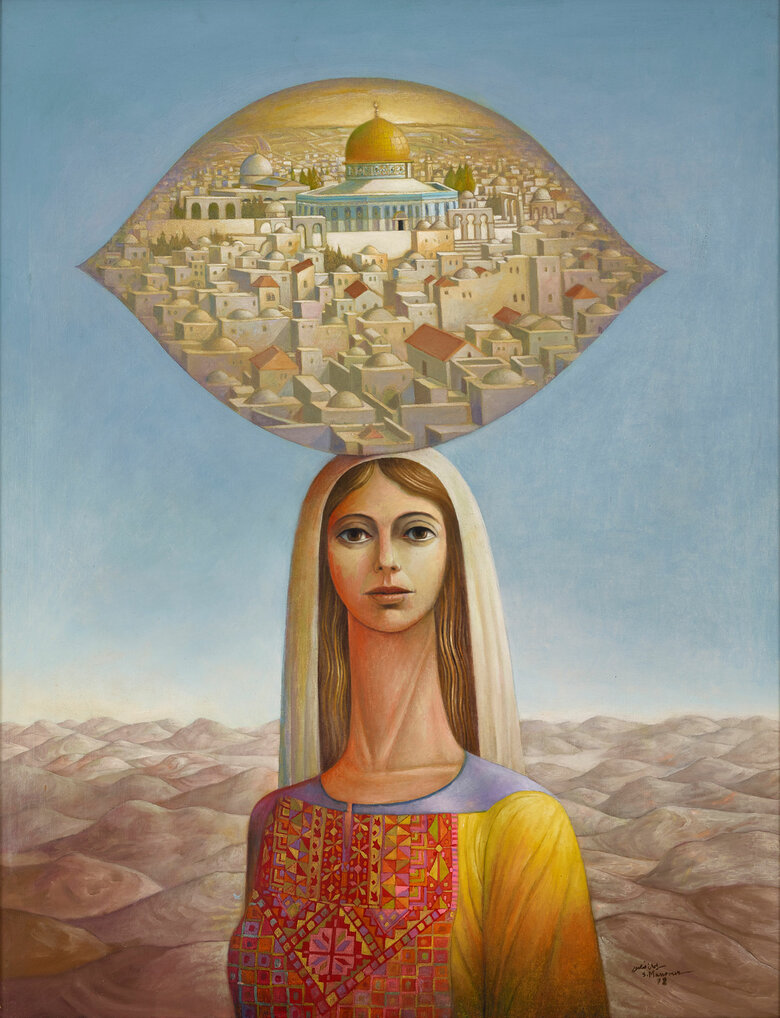

_SuleimanAnisMansour_Front.jpg)
